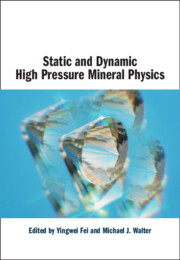Book contents
- Static and Dynamic High Pressure Mineral Physics
- Static and Dynamic High Pressure Mineral Physics
- Copyright page
- Contents
- Contributors
- 1 Introduction to Static and Dynamic High-Pressure Mineral Physics
- 2 Development of Static High-Pressure Techniques and the Study of the Earth’s Deep Interior in the Last 50 Years and Its Future
- 3 Applications of Synchrotron and FEL X-Rays in High-Pressure Research
- 4 Development of Large-Volume Diamond Anvil Cell for Neutron Diffraction: The Neutron Diamond Anvil Cell Project at ORNL
- 5 Light-Source Diffraction Studies of Planetary Materials under Dynamic Loading
- 6 New Analysis of Shock-Compression Data for Selected Silicates
- 7 Scaling Relations for Combined Static and Dynamic High-Pressure Experiments
- 8 Equations of State of Selected Solids for High-Pressure Research and Planetary Interior Density Models
- 9 Elasticity at High Pressure with Implication for the Earth’s Inner Core
- 10 Multigrain Crystallography at Megabar Pressures
- 11 Deformation and Plasticity of Materials under Extreme Conditions
- 12 Synthesis of High-Pressure Silicate Polymorphs Using Multi-Anvil Press
- 13 Investigation of Chemical Interaction and Melting Using Laser-Heated Diamond Anvil Cell
- 14 Molecular Compounds under Extreme Conditions
- 15 Superconductivity at High Pressure
- 16 Thermochemistry of High-Pressure Phases
- Index
13 - Investigation of Chemical Interaction and Melting Using Laser-Heated Diamond Anvil Cell
Published online by Cambridge University Press: 03 August 2023
- Static and Dynamic High Pressure Mineral Physics
- Static and Dynamic High Pressure Mineral Physics
- Copyright page
- Contents
- Contributors
- 1 Introduction to Static and Dynamic High-Pressure Mineral Physics
- 2 Development of Static High-Pressure Techniques and the Study of the Earth’s Deep Interior in the Last 50 Years and Its Future
- 3 Applications of Synchrotron and FEL X-Rays in High-Pressure Research
- 4 Development of Large-Volume Diamond Anvil Cell for Neutron Diffraction: The Neutron Diamond Anvil Cell Project at ORNL
- 5 Light-Source Diffraction Studies of Planetary Materials under Dynamic Loading
- 6 New Analysis of Shock-Compression Data for Selected Silicates
- 7 Scaling Relations for Combined Static and Dynamic High-Pressure Experiments
- 8 Equations of State of Selected Solids for High-Pressure Research and Planetary Interior Density Models
- 9 Elasticity at High Pressure with Implication for the Earth’s Inner Core
- 10 Multigrain Crystallography at Megabar Pressures
- 11 Deformation and Plasticity of Materials under Extreme Conditions
- 12 Synthesis of High-Pressure Silicate Polymorphs Using Multi-Anvil Press
- 13 Investigation of Chemical Interaction and Melting Using Laser-Heated Diamond Anvil Cell
- 14 Molecular Compounds under Extreme Conditions
- 15 Superconductivity at High Pressure
- 16 Thermochemistry of High-Pressure Phases
- Index
Summary
The combination of double-sided laser heating in the diamond anvil cell and detailed chemical analysis of the recovered samples is a promising approach to explore the chemistry of the Earth’s deep interior from the lower mantle to the core. Routine recovery of laser-heated samples coupled with chemical and textural characterization at the submicron scale is the key to expand knowledge of chemical interactions and melting at extreme conditions, particularly in complex systems. Recent technical developments have allowed us to investigate element partitioning and melting relations at pressures approaching the Earth’s inner-core boundary. In this chapter, we review the techniques used for recovering tiny laser-heated samples and analyzing their chemical compositions and quenched textures, while highlighting key experiments that address silicate–metal element partitioning during mantle–core differentiation, silicate melting relations with applications to early magma ocean crystallization and deep mantle melting, and melting relations in iron-alloy systems relevant to the core. The results have drastically expanded our understanding of element redistribution at deep chemical boundaries and the chemical evolution of the deep mantle and the inner core. Finally, we emphasize the need for standardized protocols to obtain consistent, reproducible results and streamlined procedures to promote good practice and increase productivity. A broad collaboration with a systematic approach would further advance the field of high-pressure geochemistry.
Information
- Type
- Chapter
- Information
- Static and Dynamic High Pressure Mineral Physics , pp. 300 - 336Publisher: Cambridge University PressPrint publication year: 2022
